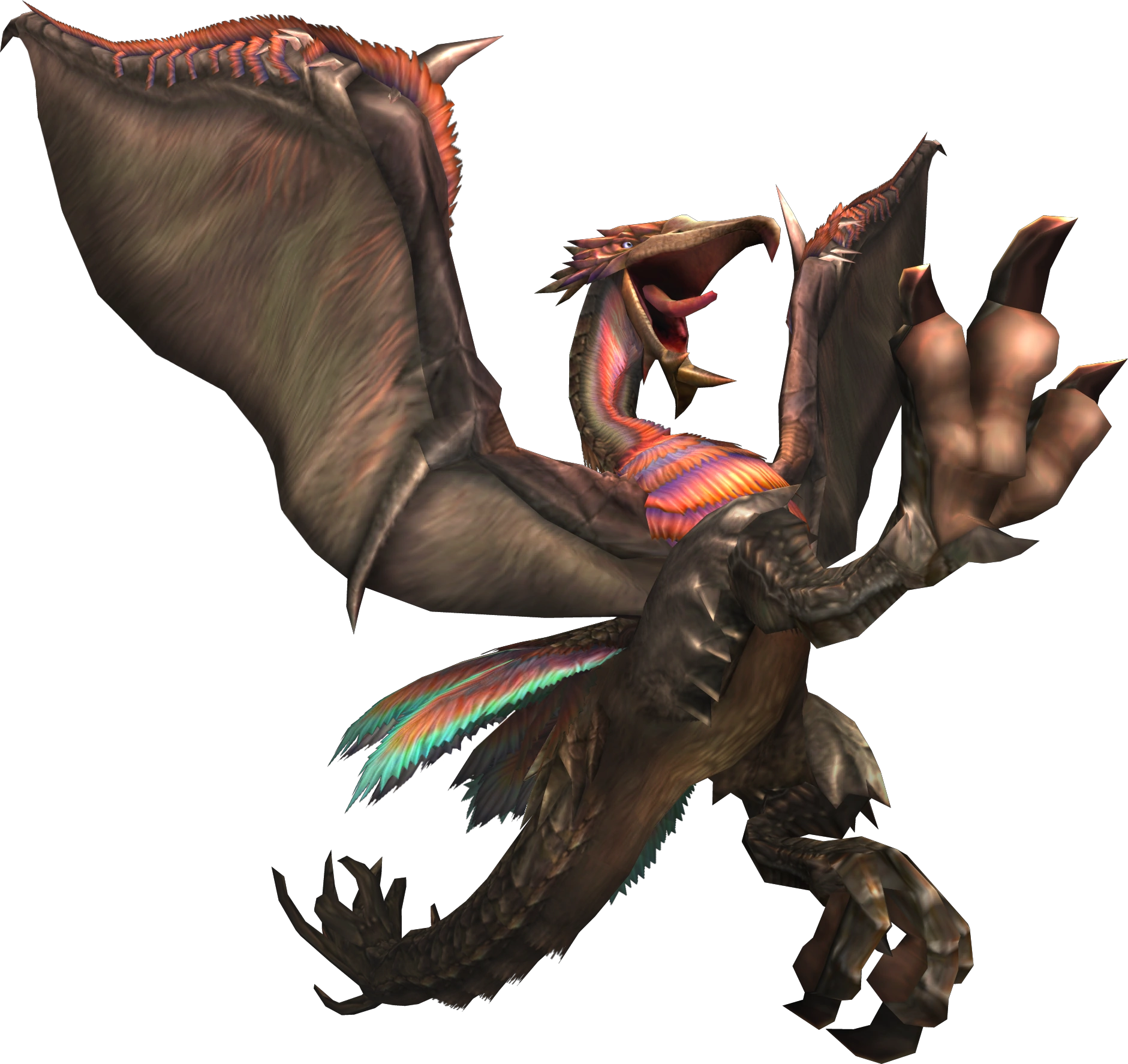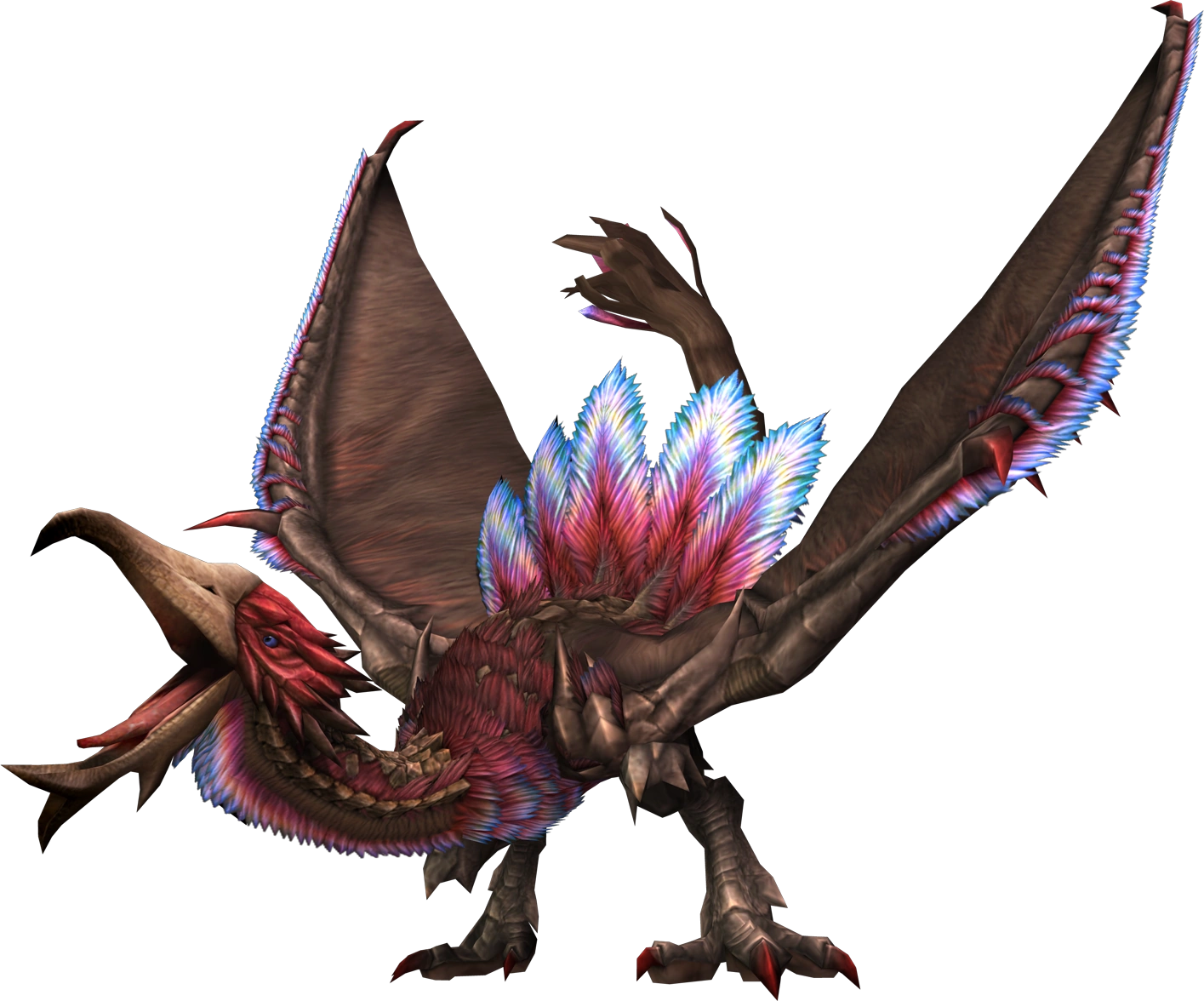 Feathered Bird Wyverns with orange and brown plumage that mostly scavenge on carrion with their sharp hooked beaks, which have two fang-like projections on the lower jaw. Despite their bird-like appearance, Hypnocatrice do not use their feathers for flight and possess membranous wings that are covered in a layer of downy feathers. It is even suspected by some that Hypnocatrice are misidentified Flying Wyverns as their wings are quite different from other Bird Wyverns. Five large display feathers that resemble a fan can be prominently seen on their back and many smaller display feathers can be found at their tail tip as well. While much of their body is feathered, their head, nape, legs and parts of their wings remain bare. Their name comes from their ability to produce and spit a volatile sleep-inducing substance.
Feathered Bird Wyverns with orange and brown plumage that mostly scavenge on carrion with their sharp hooked beaks, which have two fang-like projections on the lower jaw. Despite their bird-like appearance, Hypnocatrice do not use their feathers for flight and possess membranous wings that are covered in a layer of downy feathers. It is even suspected by some that Hypnocatrice are misidentified Flying Wyverns as their wings are quite different from other Bird Wyverns. Five large display feathers that resemble a fan can be prominently seen on their back and many smaller display feathers can be found at their tail tip as well. While much of their body is feathered, their head, nape, legs and parts of their wings remain bare. Their name comes from their ability to produce and spit a volatile sleep-inducing substance.Hypnocatrice are primarily found in lush tropical and temperate forests but have also been encountered in desolate desert areas. Although they prefer to feed on carrion most of the time, they are omnivorous and can feed on just about anything. They are known to feed on fish, small animals, insects and many different kinds of plants.*In fact, they actually obtain their signature sleep-inducing compounds from certain foods such as Sleepyfish, Sleep Herbs and insects.* When hunting to feed their offspring, they might put their prey to sleep before carrying it back to their nest, but generally their strong legs are already sufficient in helping them chase down and kill prey. Lacking teeth, they swallow pebbles and grit to help them crush and grind the food in their stomach. These gastroliths may be introduced to a Hypnocatrice at the moment of its birth and mature along with it to become a prized "Hypno Bezoar". The stone's ceramic appearance possibly comes from a combination of the Hypnocatrice's hypnotic fumes and weak stomach fluids, which could have formed a whitish solution that solidifies on the bezoar.
Quite pacifistic by nature, Hypnocatrice prefer to put enemies to sleep and run from the fight. While usually timid, when angered they may also viciously kick and slash sleeping foes with their powerful legs and sharp claws in an attempt to make them leave their territory. Besides that, they can also use their tail as a weapon while fighting. If enraged, they will erect the large feathers on their back to look more threatening.
 During the mating season, the feathers of mature male Hypnocatrice will turn a brilliant shade of blue and magenta and they will perform mating dances to attract females. These individuals become known as Breeding Season Hypnocatrice to differentiate them from normal Hypnocatrice, as they become more aggressive during this period.
During the mating season, the feathers of mature male Hypnocatrice will turn a brilliant shade of blue and magenta and they will perform mating dances to attract females. These individuals become known as Breeding Season Hypnocatrice to differentiate them from normal Hypnocatrice, as they become more aggressive during this period.